Chandragupta Maurya
Early Life and Background
Chandragupta Maurya, the founder of the Maurya Empire, was born around 340 BCE. His early life is shrouded in mystery, with various sources providing differing accounts of his origins. According to some texts, he was born into a humble family, while others suggest he was of noble descent. His rise to power was significantly influenced by his mentor and advisor, Chanakya, also known as Kautilya or Vishnugupta, a renowned teacher at the ancient university of Takshashila.
Rise to Power
Chandragupta's ascent to power began with his encounter with Chanakya, who had been insulted by the Nanda dynasty. Chanakya saw potential in Chandragupta and trained him in the arts of warfare and statecraft. Together, they formed a formidable alliance and began their campaign against the Nanda rulers of Magadha. Through a combination of military strategy, diplomacy, and subterfuge, Chandragupta managed to overthrow the Nanda dynasty and establish the Maurya Empire around 322 BCE.
Establishment of the Maurya Empire
Upon seizing power, Chandragupta embarked on a series of military campaigns to expand his empire. He first consolidated his control over the Indo-Gangetic Plain, a region of immense agricultural and economic importance. His next significant conquest was the region of Punjab, which was under the control of the remnants of Alexander the Great's empire. Chandragupta's forces clashed with the Greek satraps, eventually leading to the Treaty of the Indus around 305 BCE, which secured the northwestern territories for the Maurya Empire.
Administration and Governance
Chandragupta's administration was highly centralized and efficient, drawing heavily from the principles outlined in Chanakya's treatise, the Arthashastra. The empire was divided into various provinces, each governed by a viceroy appointed by the emperor. The provinces were further subdivided into districts and villages, with local officials responsible for maintaining law and order, collecting taxes, and overseeing agricultural production.
The Maurya administration also placed a strong emphasis on espionage and intelligence gathering. A network of spies and informants was established to keep the emperor informed about the activities within the empire and potential threats from outside.
Economic Policies
The economic policies of Chandragupta's reign were designed to promote agricultural productivity and trade. The state played a significant role in regulating economic activities, including the standardization of weights and measures, and the establishment of state-controlled warehouses and granaries. The empire's extensive network of roads and trade routes facilitated the movement of goods and people, contributing to economic prosperity.
Military Organization
Chandragupta's military was one of the most formidable forces of its time. The army was well-organized and consisted of infantry, cavalry, chariots, and war elephants. The Mauryan army was known for its discipline and the strategic use of war elephants, which played a crucial role in battles. The military was supported by a robust logistical system that ensured a steady supply of provisions and equipment.
Relations with the Hellenistic World
Chandragupta's interactions with the Hellenistic world were marked by both conflict and diplomacy. After his initial military engagements with the Greek satraps, he established a diplomatic relationship with Seleucus I Nicator, one of Alexander the Great's generals. The Treaty of the Indus not only secured territorial gains for the Maurya Empire but also led to a marriage alliance between Chandragupta and a daughter of Seleucus. This alliance facilitated cultural and economic exchanges between the Mauryan and Hellenistic worlds.
Religious and Cultural Contributions
Chandragupta's reign saw significant religious and cultural developments. Although he was initially a follower of Hinduism, he later converted to Jainism under the influence of the Jain monk Bhadrabahu. His conversion to Jainism had a profound impact on his life and policies. According to Jain tradition, Chandragupta eventually abdicated the throne in favor of his son, Bindusara, and retired to a life of asceticism in Karnataka, where he is believed to have fasted to death in the Jain tradition of Sallekhana.
Legacy
Chandragupta Maurya's legacy is one of remarkable achievements in statecraft, military conquest, and administration. He laid the foundation for one of the largest and most powerful empires in ancient India, which reached its zenith under his grandson, Ashoka the Great. Chandragupta's life and reign have been the subject of numerous historical and literary works, reflecting his enduring influence on Indian history.
See Also


